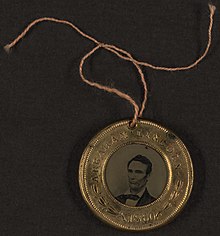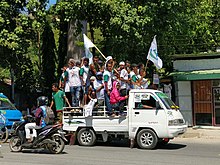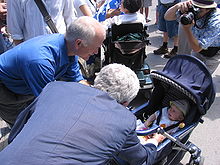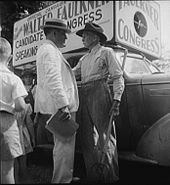Presidential campaign button for Abraham Lincoln, 1860. The reverse side of the button shows a portrait of his running mate Hannibal Hamlin.
A political campaign is an organized effort which seeks to influence the decision making progress within a specific group. In democracies, political campaigns often refer to electoral campaigns, by which representatives are chosen or referendums are decided. In modern politics, the most high-profile political campaigns are focused on general elections and candidates for head of state or head of government, often a president or prime minister.
Campaign message
Election campaign in East Timor: Truck Rally
The message of the campaign contains the ideas that the candidate wants to share with the voters.
It is to get those who agree with their ideas to support them when running for a political position.
The message often consists of several talking points
about policy issues.
The points summarize the main ideas of the campaign and are repeated
frequently in order to create a lasting impression with the voters. In
many elections, the opposition party will try to get the candidate "off
message" by bringing up policy or personal questions that are not
related to the talking points. Most campaigns prefer to keep the message
broad in order to attract the most potential voters. A message that is
too narrow can alienate voters or slow the candidate down with
explaining details.
For example, in the 2008 American presidential election John McCain
originally used a message that focused on his patriotism and political
experience: "Country First"; later the message was changed to shift
attention to his role as "The Original Maverick" within the political
establishment. Barack Obama
ran on a consistent, simple message of "change" throughout his
campaign. However, even if the message is crafted carefully, it does not
assure the candidate a victory at the polls. For a winning candidate,
the message is refined and then becomes his or her in office.
Campaign finance
Fundraising techniques include having the candidate call or meet with
large donors, sending direct mail pleas to small donors, and courting
interest groups who could end up spending millions on the race if it is
significant to their interests.
Organization
In a modern political campaign, the campaign organization (or
"machine") will have a coherent structure of personnel in the same
manner as any business of similar size.
Campaign manager
Successful campaigns usually require a campaign manager to coordinate
the campaign's operations. Apart from a candidate, they are often a
campaign's most visible leader. Modern campaign managers may be
concerned with executing strategy rather than setting it - particularly
if the senior strategists are typically outside political consultants such as primarily pollsters and media consultants.
Political consultants
Political consultants advise campaigns on virtually all of their
activities, from research to field strategy. Consultants conduct
candidate research, voter research, and opposition research for their clients.
Activists
Activists are the "foot soldiers" loyal to the cause, the true believers who will carry the run by volunteer activists. Such volunteers and interns may take part in activities such as canvassing door-to-door and making phone calls on behalf of the campaigns.
Techniques
Democrat John Edwards makes a campaign speech in Pittsburgh, Pennsylvania in 2007.
A campaign team (which may be as small as one inspired individual, or
a heavily resourced group of professionals) must consider how to communicate the message of the campaign, recruit volunteers, and raise money. Campaign advertising draws on techniques from commercial advertising and propaganda, also entertainment and public relations, a mixture dubbed politainment.
The avenues available to political campaigns when distributing their
messages is limited by the law, available resources, and the imagination
of the campaigns' participants. These techniques are often combined
into a formal strategy known as the campaign plan.
The plan takes account of a campaign's goal, message, target audience,
and resources available. The campaign will typically seek to identify
supporters at the same time as getting its message across.
The modern, open campaign method was pioneered by Aaron Burr during the American presidential election of 1800.
Campaign communication
Election campaign communication refers to party-controlled communication, e.g. campaign advertising, and party-uncontrolled communication, e.g. media coverage of elections.
Campaign advertising
Campaign advertising is the use of paid media (newspapers, radio,
television, etc.) to influence the decisions made for and by groups.
These ads are designed by political consultants and the campaign's staff.
Media management
The public media (in US parlance "free media" or "earned media")
may run the story that someone is trying to get elected or to do
something about certain aspects regarding their specific country.
Demonstrations
A political rally in Chinatown, Los Angeles, featuring Betty Ford campaigning for her husband, U.S. President Gerald Ford, during the 1976 presidential campaign.
Modern technology and the internet
The internet is now a core element of modern political campaigns. Communication technologies such as e-mail, websites, and podcasts
for various forms of activism enable faster communications by citizen
movements and deliver a message to a large audience. These Internet
technologies are used for cause-related fundraising, lobbying,
volunteering, community building, and organizing. Individual political
candidates are also using the internet to promote their election
campaign. In a study of Norwegian election campaigns, politicians
reported they used social media for marketing and for dialogue with
voters. Facebook was the primary platform for marketing and Twitter was
used for more continuous dialogue.
Signifying the importance of internet political campaigning, Barack Obama's presidential campaign relied heavily on social media, Search Engine Optimisation (SEO) and new media channels to engage voters, recruit campaign volunteers, and raise campaign funds.
The campaign brought the spotlight on the importance of using internet
in new-age political campaigning by utilizing various forms of social media and new media
(including Facebook, YouTube and a custom generated social engine) to
reach new target populations. The campaign's social website,
my.BarackObama.com, utilized a low cost and efficient method of
mobilizing voters and increasing participation among various voter
populations.
This new media was incredibly successful at reaching the younger
population while helping all populations organize and promote action.
Now Online Election campaign has got a new dimension, the
campaign information can be shared as in Rich Info format through
campaign landing pages, integrating Google's rich snippets, structured
data, Social media open graphs, and husting support file formats for YouTube like .sbv (SubRip),
.srt (subtitle resource track), .vtt (Video text trace), high
proficiency and effective algorithmic integration will be the core
factor in the frame-work. This technology integration helps campaign
information to reach a wide audience in split seconds. This has
successfully been tested and implemented in 2015 Aruvikkara Election
Kerala.
Marcus Giavanni, social media consultant and blockchain developer and
second place opponent in the 2015 election, was first to file for the
2019 election. Marcus Giavanni Uses Advanced Algorithms, Artificial
Intelligence, and Voice Indexing Predictions to box in campaigns.
Husting
A husting, or the hustings, was originally a physical platform from
which representatives presented their views or cast votes before a
parliamentary or other election body. By metonymy, the term may now
refer to any event, such as debates or speeches, during an election
campaign where one or more of the representative candidates are present.
Search Engine Manipulation Effect (SEME)
Search Engine Manipulation Effect (SEME), and the ability to reach
the millennial demographic over social media and search engines, has
become an important component to online Husting-based campaign efforts.
It's evident that SEME can influence unbiased voters heavily, a study by Mr. Ronald E. Robertson
(Senior Research Psychologist at the American Institute of Behavioural
Research and Technology and the former editor in chief of Psychology
Today).
Other techniques
NDP leader Jack Layton and Bloc Québécois leader Gilles Duceppe greet babies - a traditional campaign activity - at the Fête nationale du Québec in Montreal
- Writing directly to members of the public (either via a professional marketing firm or, particularly on a small scale, by volunteers)
- By distributing leaflets or selling newspapers
- Through websites, online communities, and solicited or unsolicited bulk email
- Through a new technique known as microtargeting that helps identify and target small demographic slices of voters
- Through a whistlestop tour - a series of brief appearances in several small towns
- Hampering the ability of political competitors to campaign, by such techniques as counter-rallies, picketing of rival parties’ meetings, or overwhelming rival candidates' offices with mischievous phone calls (most political parties in representative democracies publicly distance themselves from such disruptive and morale-affecting tactics, with the exception of those parties self-identifying as activist
- Organizing political house parties
- Using endorsements of other celebrated party members to boost support
- Remaining close to or at home to make speeches to supporters who come to visit as part of a front porch campaign
- Vote-by-mail, previously known as "absentee ballots" have grown significantly in importance as an election tool. Campaigns in most states must have a strategy in place to impact early voting
- Sale of official campaign merchandise (colloquially known as Swag,
in reference to the baiting technique) as a way of commuting a
competitor's popularity into campaign donations, volunteer recruitment,
and free advertising
Campaign types
Informational campaign
An
informational campaign is a political campaign designed to raise public
awareness and support for the positions of a candidate (or her/his
party).
It is more intense than a paper campaign, which consists of little more
than filing the necessary papers to get on the ballot, but is less
intense than a competitive campaign, which aims to actually win election
to the office. An informational campaign typically focuses on low-cost
outreach such as news releases, getting interviewed in the paper, making
a brochure for door to door distribution, organizing poll workers, etc.
Paper campaign
A paper campaign is a political campaign in which the candidate only files the necessary paperwork to appear on the ballot.
The purpose of such a token effort may be simply to increase name
awareness of a minor political party or to give voters of a certain
ideology an opportunity to vote accordingly. It can be a cost-effective
means of attracting media coverage. An informational campaign, by
contrast, may involve news releases, newspaper interviews, door-to-door
campaigning, and organizing polls. As the level of seriousness rises,
the marginal cost of reaching more people rises accordingly, due to the
high cost of TV commercials, paid staff, etc. which are used by
competitive campaigns.
Modern election campaigns in the United States
Types of elections
Walter Faulkner, candidate for U.S. Congress in 1938, campaigns in person with a farmer in Crossville, Tennessee (photo by Dorothea Lange)
The United States is unusual in that dozens of different offices are filled by election, from drain commissioner to the President of the United States. Elections happen every year on many different dates in many different areas of the country.
All federal elections (that is, elections for president and vice president as well as elections to the House of Representatives and Senate) are partisan. Elections to most (but not all) statewide offices are partisan as well, and all state legislatures except for Nebraska are partisan.
Some state and local offices are non-partisan - these often include judicial elections, special district elections (the most common of which are elections to the school board, and elections to municipal (town council, city commission, mayor) and county (county commission, district attorney, sheriff)
office. In some cases, candidates of the same political party
challenging each other and in many cases without any campaign references
to political parties, while in other cases, even non-partisan races may
take on partisan overtones.
Process of campaigning
U.S. President Richard Nixon campaigns in 1972 by "working the crowd" and shaking hands with supporters.
Major campaigns in the United States are often much longer than those in other democracies.
Campaigns start anywhere from several months to several years before election day.
The first part of any campaign for a candidate is deciding to run.
Prospective candidates will often speak with family, friends,
professional associates, elected officials, community leaders, and the
leaders of political parties before deciding to run. Candidates are
often recruited by political parties and lobby groups
interested in electing like-minded politicians. During this period,
people considering running for office will consider their ability to put
together the money, organization, and public image needed to get
elected. Many campaigns for major office do not progress past this point
as people often do not feel confident in their ability to win. However,
some candidates lacking the resources needed for a competitive campaign
proceed with an inexpensive paper campaign or informational campaign designed to raise public awareness and support for their positions.
Once a person decides to run, they will make a public
announcement. This announcement could consist of anything from a simple
press release to concerned media outlets to a major media event followed
by a speaking tour. It is often well known to many people that a
candidate will run prior to an announcement being made. Campaigns will
often be announced and then only officially "kicked off" months after
active campaigning has begun. Being coy about whether a candidacy is
planned is often a deliberate process by a prospective candidate, either
to "test the waters" or to keep the media's attention.
One of the most important aspects of the major American political
campaign is the ability to raise large sums of money, especially early
on in the race. Political insiders and donors often judge candidates
based on their ability to raise money. Not raising enough money early on
can lead to problems later as donors are not willing to give funds to
candidates they perceive to be losing, a perception based on their poor
fundraising performance.
Also during this period, candidates travel around the area they
are running in and meet with voters; speaking to them in large crowds,
small groups, or even one-on-one. This allows voters to get a better
picture of who a candidate is than that which they read about in the
paper or see on television. Campaigns sometimes launch expensive media
campaigns during this time to introduce the candidate to voters,
although most wait until closer to election day.
Campaigns often dispatch volunteers into local communities to
meet with voters and persuade people to support the candidate. The
volunteers are also responsible for identifying supporters, recruiting
them as volunteers or registering them to vote if they are not already
registered. The identification of supporters will be useful later as
campaigns remind voters to cast their votes.
Late in the campaign, campaigns will launch expensive television,
radio, and direct mail campaigns aimed at persuading voters to support
the candidate. Campaigns will also intensify their grassroots campaigns,
coordinating their volunteers in a full court effort to win votes.
Voting in the United States often starts weeks before election
day as mail-in ballots are a commonly used voting method. Campaigns will
often run two persuasion programs, one aimed at mail-in voters and one
aimed at the more traditional poll voters.
Campaigns for minor office may be relatively simple and
inexpensive - talking to local newspapers, giving out campaign signs,
and greeting people in the local square.
Political consultants
Political campaigns in the United States are not merely a civic
ritual and occasion for political debate, but a multibillion-dollar
industry, dominated by professional political consultants using sophisticated campaign management tools, to an extent far greater than elsewhere in the world. Though the quadrennial presidential election attracts the most attention, the United States
has a huge number of elected offices and there is wide variation
between different states, counties, and municipalities on which offices
are elected and under what procedures. Moreover, unlike democratic
politics in much of the rest of the world, the US has relatively weak
parties. While parties play a significant role in fundraising and
occasionally in drafting people to run, campaigns are ultimately
controlled by the individual candidates themselves.
Other issues and criticisms
Cost of campaign advertising
American political campaigns have become heavily reliant on broadcast media and direct mail
advertising (typically designed and purchased through specialized
consultants). Though virtually all campaign media are sometimes used at
all levels (even candidates for local office have been known to purchase
cable TV ads), smaller, lower-budget campaigns are typically more
focused on direct mail, low-cost advertising (such as lawn signs), and direct voter contact.
This reliance on expensive advertising is a leading factor behind the
rise in the cost of running for office in the United States. This rising
cost is considered by some to discourage those without well-monied
connections, or money themselves, from running for office.
Independent expenditures
Money is raised and spent not only by candidate's campaign, but also by party committees, political action committees, and other groups (in the 2004 election cycle, much controversy has focused on a new category of organization, 527 groups). This is sometimes done through independent expenditures
made in support or opposition of specific candidates but without any
candidate's cooperation or approval. The lack of an overt connection
between a candidate and third party groups allows one side of a campaign
to attack the other side while avoiding criticism for going negative. A
memorable example are the Swift Boat Veterans who criticized John Kerry in the 2004 Presidential campaign.
Future developments
Many
political players and commentators agree that American political
campaigns are currently undergoing a period of change, due to increased
use of the internet,
which has become a valuable fundraising tool. This has led to the
development of digital marketing, where customers can be targeted by
demographic factors such age, location and occupation.
However, as modern technology continues to adapt to changes in
society, Internet campaigning will never be able to serve as a complete
replacement for traditional political
campaigning without reducing the significant barriers to entry.
Internet political campaigning leaves out entire portions of each
population because it only is accessible to a certain portion of the
population, leaving those without this access disconnected.
For example, during Obama's recent presidential campaign,
Internet political campaigning was supposedly effective at reaching the
younger population, as they remain engaged with social websites and new
media.
Because of the limits of technology, Obama's Internet campaign failed
to reach older generations who didn't use this new media, as well as
significant amounts of the population who didn't have access.
Effects
A
forthcoming study in the American Political Science Review found that
campaigns have "an average effect of zero in general elections".
The study found two instances where campaigning was effective: "First,
when candidates take unusually unpopular positions and campaigns invest
unusually heavily in identifying persuadable voters. Second, when
campaigns contact voters long before election day and measure effects
immediately — although this early persuasion decays."
Presidential campaigns
A
large body of political science research emphasizes how "fundamentals" -
the state of the economy, whether the country is at war, how long the
president's party has held the office, and which candidate is more
ideologically moderate - predict presidential election outcomes.
However, campaigns may be necessary to enlighten otherwise uninformed
voters about the fundamentals, which thus become increasingly predictive
of preferences as the campaign progresses.
Research suggests that "the 2012 presidential campaigns increased
turnout in highly targeted states by 7–8 percentage points, on average,
indicating that modern campaigns can significantly alter the size and
composition of the voting population.".
National conventions
A
consensus in the political science literature holds that national
conventions usually have a measurable effect on presidential elections
that is relatively resistant to decay.
Presidential and vice-presidential debates
Research is mixed on the precise impact of debates.
Rather than encourage viewers to update their political views in
accordance with the most persuasive arguments, viewers instead update
their views to merely reflect what their favored candidate is saying.
Presidential primaries
The
fundamentals matter less in the outcome of presidential primaries. One
prominent theory holds that the outcome of presidential primaries is
largely determined by the preferences of party elites.
Presidential primaries are therefore less predictive, as all kinds of
events may impact elites' perception of the viability of candidates.
Gaffes, debates and media narratives play a greater role in primaries
than in presidential elections.
Strategies
Traditional ground campaigning and voter contacts remain the most effective strategies. Some research suggests that knocking on doors can increase turnout by as much as 10% and phone calls by as much as 4%. One study suggests that lawn signs increase vote share by 1.7 percentage points.
A review of more than 200 get-out-the-vote experiments finds that the
most effective tactics are personal: Door-to-door canvassing increases
turnout by an average of about 2.5 percentage points; volunteer phone
calls raise it by about 1.9 points, compared to 1.0 points for calls
from commercial phone banks; automated phone messages are ineffective. Each field office that the Obama campaign opened in 2012 gave him approximately a 0.3% greater vote share. The Obama 2008 campaign's use of field most offices has been credited as crucial in winning Indiana and North Carolina. According to one study, the cost per vote by having a field office is $49.40. Using out-of-state volunteers for canvassing is less effective in increasing turnout than using local and trained volunteers.
Political science research generally finds negative advertisement (which has increased over time) to be ineffective both at reducing the support and turnout for the opponent.
According to political scientists Stephen Ansolabehere and Shanto
Iyengar, negative ads do succeed at driving down overall turnout though.
They also find that "negative ads work better for Republicans than for
Democrats, and better for men than for women; unfortunately, negative
ads also work better in general than positive ones." Challengers who spend more time campaigning get a higher vote share against incumbents in state house elections.
According to political scientist Lynn Vavreck, "the evidence suggests
that campaign ads have small effects that decay rapidly — very rapidly —
but just enough of the impact accumulates to make running more
advertising than your opponent seem a necessity." A 2019 study of online political advertising conducted by a party in the 2016 Berlin state election
campaign found that the online-ad campaign "increased the party's vote
share by 0.7 percentage points" and that factual ads were more effective
than emotional ads.
According to political scientists Donald Green
and Alan Gerber, it costs $31 to produce a vote going door to door,
$91-$137 to produce a vote by sending out direct mailers, $47 per vote
from leafletting, $58-$125 per vote from commercial phone banking, and
$20-$35 per vote from voluntary phone banking. A 2018 study in the American Economic Review
found that door-to-door canvassing on behalf of the Francois Hollande
campaign in the 2012 French presidential election "did not affect
turnout, but increased Hollande's vote share in the first round and
accounted for one fourth of his victory margin in the second. Visits'
impact persisted in later elections, suggesting a lasting persuasion
effect."
According to a 2018 study, repeated get-out-the-vote phone calls had
diminishing effects but each additional phone call increased the
probability to vote by 0.6-1.0 percentage points.
Another 2018 study found that "party leaflets boost turnout by 4.3
percentage points while canvassing has a small additional effect (0.6
percentage points)" in a United Kingdom election.
A 2016 study found that visits by candidate visits to states have
modest effects: "visits are most effective in influencing press
coverage at the national level and within battleground states. Visits’
effects on voters themselves, however, are much more modest than
consultants often claim, and visits appear to have no effects outside
the market that hosts a visit."
The authors of the study argue that it would be more effective for
campaigns to go to the pockets of the country where wealthy donors are
(for fundraising) and hold rallies in the populous states both to
attract national press and raise funds.
A 2005 study found that campaign visits had no statistically
significant effect, after controlling for other factors, on voter
turnout in the 1992, 1996, and 2000 elections.
On the other hand, a 2017 paper of the 1948 presidential election
provides "strong evidence that candidate visits can influence electoral
returns". Other research also provides evidence that campaign visits increase vote share.
History
Political campaigns have existed as long as there have been informed citizens to campaign amongst. Democratic societies
have regular election campaigns, but political campaigning can occur on
particular issues even in non-democracies so long as freedom of
expression is allowed. Often mass campaigns are started by the less
privileged or anti-establishment viewpoints (as against more powerful
interests whose first resort is lobbying). The phenomenon of political campaigns are tightly tied to lobby groups and political parties.
The first modern campaign is often described as William Ewart Gladstone's Midlothian campaign in 1878-80, although there may be earlier recognizably modern examples from the 19th century. The 1896 William McKinley presidential campaign laid the groundwork for modern campaigns.
In the 1790-1820s, the Federalist Party and the Democratic-Republican Party battled it out in the so-called "First Party System". American election campaigns in the 19th century created the first mass-base political parties and invented many of the techniques of mass campaigning.








